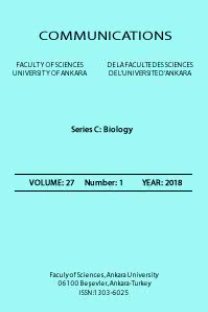Histochemical effects of brodifacoum on rat spleen
Histochemical effects of brodifacoum on rat spleen
brodifacoum, Rattus norvegicus, spleen, histochemistry, anticoagulant, CD4 T lymphocyte CD8 T lymphocyte, light microscope,
___
- Walther, B., Geduhn, A., Schenke, D. & Jacob, J. Exposure of passerine birds to brodifacoum during management of Norway rats on farms. Science of the Total Environment, 762, (2021), 144160. https://doi.org/10.1016/j.scitotenv.2020.144160
- Albert, C.A., Wilson, L.K., Mineau, P., Trudeau, S. & Elliott, J.E. Anticoagulant rodenticides in three owl species from western Canada, 1988-2003. Archives of Environ. Cont. and Toxicology, 58, (2010), 451–459. https://doi.org/10.1007/s00244-009-9402-z
- Chu, Y.-J., Lin, J.-H. & Hung, D.-Z. Oral administration of injectable vitamin K1 in Brodifacoum intoxication. BioMedicine, 12, (2022), 47–49. https://doi.org/10.37796/2211-8039.1305
- Mosterd, J.J. & Thijssen, H.H.W. The long-term effects of the rodenticide, brodifacoum, on blood coagulation and vitamin K metabolism in rats. British Journal of Pharmacol, 535, (1991), 531–535. https://doi.org/10.37796/221-039.1305
- Elliott, J.E., Hindmarch, S., Albert, C.A., Emery, J., Mineau, P. & Maisonneuve, F. Exposure pathways of anticoagulant rodenticides to nontarget wildlife. Environ. Monit. Assess., 186, (2014). https://doi.org/10.1007/s10661-013-3422-x
- Nosal, D.G., van Breemen, R.B., Haffner, J.W., Rubinstein, I. & Feinstein, D.L. Brodifacoum pharmacokinetics in acute human poisoning: implications for estimating duration of vitamin K therapy. Toxicol. Commun., 5, (2021), 69–72. https://doi.org/10.1080/24734306.2021.1887637
- Breckenridge, A.M., Cholerton, S., Hart, J.A., Park, B.K. & Scott, A.K. A study of the relationship between the pharmacokinetics and the pharmacodynamics of the 4-hydroxycoumarin anticoagulants warfarin, difenacoum and brodifacoum in the rabbit. British Journal of Pharmacology, 84, (1985), 81–91.
- Eason, C.T., Murphy, E.C., Wright, G.R.G. & Spurr, E.B. Assessment of risks of brodifacoum to non-target birds and mammals in New Zealand. Ecotoxicology, 11, (2002), 35–48. https://doi.org/10.1023/a:1013793029831
- Tosh D.G., McDonald R.A., Bearhop S., Lllewellyn N.R., Fee S., Sharp E.A., Barnett E.A., Shore R.F. Does small mammal prey guild affect the exposure of predators to anticoagulant rodenticides?. Environmental Pollution, 159, (2011), 3106–3112. https://doi.org/10.1016/j.envpol.2011.03.028
- Stansley, W., Cummings, M., Vudathala, D. & Murphy, L.A. Anticoagulant rodenticides in red-tailed hawks, Buteo jamaicensis, and great horned owls, Bubo virginianus, from New Jersey, USA, 2008–2010. Bulletin of Environmental Contamination and Toxicology Toxicol., 92, (2014), 6–9. https://doi.org/10.1007/s00128-013-1135-z
- Mebius, R.E. & Kraal, G. Structure and function of the spleen. Nature Reviews Immunology, 5, (2005), 606–616. https://doi.org/10.1038/nri1669
- Cesta, M.F. Normal structure, function, and histology of the spleen. Toxicologic Pathology, 34, (2006), 455–465. https://doi.org/10.1080/01926230600867743
- Fabrizio, V.A., Rodriguez-Sanchez, M.I., Mauguen, A., Dahi, P.B., Doubrovina, E., O’Reilly, R.J. & Prockop, S.E. Adoptive therapy with CMV-specific cytotoxic T lymphocytes depends on baseline CD4+ immunity to mediate durable responses. Blood Advances 5.2 (2021), 496-503. https://doi.org/10.1182/bloodadvances.2020002735
- Ademokun, A.A. & Dunn-Walters, D. Immune Responses: Primary and Secondary. eLS, (2010). https://doi.org/10.1002/9780470015902.a0000947.pub2
- Langeveld, M., Gamadia, L.E. & Ten Berge, I.J.M. T-lymphocyte subset distribution in human spleen. European Journal of Clinical Investigation, 36, (2006), 250–256. https://doi.org/10.1111/j.1365-362.2006.01626.x
- Falchetti, R., Lanzilli, G., Casalinuovo, I.A., Gaziano, R., Palamara, A.T., Di Francesco, P., Ravagnan, G. & Garaci, E. Splenic CD4+and CD8+T cells from influenza immune mice concurrently produce in vitro IL2, IL4, and IFN-γ. Cellular Immunology, 170, (1996), 222–229. https://doi.org/10.1006/cimm.1996.0155
- Hadler, M.R. & Buckle, A.P. Forty five years of anticoagulant rodenticides—past, present and future trends. Proceedings of the Fifteenth Vertebrate Pest Conference (1992), 149–155.
- Whiteland, J.L., Nicholls, S.M., Shimeld, C., Easty, D.L., Williams, N.A. & Hill, T.J. Immunohistochemical detection of T-cell subsets and other leukocytes in paraffin-embedded rat and mouse tissues with monoclonal antibodies. Journal of Histochemistry and Cytochemistry, 43, (1995), 313–320. https://doi.org/10.1177/43.3.7868861
- Murphy, K M., Reiner, S.L. The lineage decisions of helper T-cells. Nature Reviews Immunology, 2, (2002), 933–944. https://doi.org/10.1038/nri954
- Chen, W., Jin, W., Hardegen, N., Lei, K.J., Li, L., Marinos, N., McGrady, G. & Wahl, S.M. Conversion of peripheral CD4+CD25− naive T-cells to CD4+CD25+ regulatory T-cells by TGF-β induction of transcription factor foxp3. Journal of Experimental Medicine, 198, (2004), 1875–1886. https://doi.org/10.1084/jem.20030152
- Jin, E., Li, S., Ren, M., Hu, Q., Gu, Y., & Li, K. Boron affects immune function through modulation of splenic T-lymphocyte subsets, cytokine secretion, and lymphocyte proliferation and apoptosis in rats. Biological Trace Element Research, 178, (2017), 261–275. https://doi.org/10.1007/s12011-017-0932-3
- Omar, H.E.-D.M., Saad Eldien, H.M., Badary, M.S., Al-Khatib, B.Y. & AbdElgaffar, S.K. The immunomodulating and antioxidant activity of fucoidan on the splenic tissue of rats treated with cyclosporine A. The Journal of Basic and Applied Zoology, 66, (2013), 243–254. https://doi.org/10.1016/j.jobaz.2013.05.003
- Saad, A.J. & Jerrells, T.R. Flow cytometric and immunohistochemical evaluation of ethanol‐induced changes in splenic and thymic lymphoid cell populations. Alcoholism: Clinical and Exper. Research, 15, (1991), 796–803. https://doi.org/10.1111/j.1530-0277.1991.tb00603.x
- Neishabouri, E., Hassan, Z.M. & Ostad, S. Humoral and cellular immunomodulation induced by propoxure in C57-bl/6 mice. Iranian Journal of Pharmaceutical Research, 3, (2004), 41–45. https://doi.org/10.22037/ijpr.2010.295
- Falchetti, R., Lanzilli, G., Casalinuovo, I.A., Gaziano, R., Palamara, A.T., Di Francesco, P., Ravagnan, G. & Garaci, E. Splenic CD+ and CD8+T cells from influenza immune mice concurrently produce in vitro IL2, IL4, and IFN-. Cellular Immunology, 170, (1996), 222–229. https://doi.org/10.1006/cimm.1996.0155
- Fujitani, T., Tada, Y. & Yoneyama, M. Chlorpropham-induced splenotoxicity and its recovery in rats. Food and Chem. Toxicology, 42, (2004), 1469–1477. https://doi.org/10.1016/j.fct.2004.04.008
- Valchev, I., Binev, R., Yordanova, V. & Nikolov, Y. Anticoagulant rodenticide intoxication in animals - A review. Turkish Journal of Veterinary & Animal Sciences, 32, (2008), 237–243.
- Maamar, H., Mallem, L. & Boulakoud, M.S. The effect of the anticoagulant rodenticide “Brodifacoum” on the bioindicators parameters in male rabbit. Annals of Biological Research, (2013), 53-61.
- ISSN: 1303-6025
- Yayın Aralığı: Yılda 2 Sayı
- Başlangıç: 1943
- Yayıncı: Ankara Üniversitesi
Çubuk stream pollution and environmental effects
Tahir ATICI, Didem BALOĞLU ONGAR
Serap SEZER, Yaşar Murat ELÇİN
Histochemical effects of brodifacoum on rat spleen
Burcu BAYRAMLI ÖNER, Nursel GÜL
First records for benthic macroinvertebrate fauna in Güzeldere Waterfall, Turkey
The effect of melatonin on rat soleus muscle treated with carbon tetrachloride
Duygu Fevziye VURAL, Hatice MUTLU EYİSON, Dilşad ÖZERKAN, Suna CEBESOY
